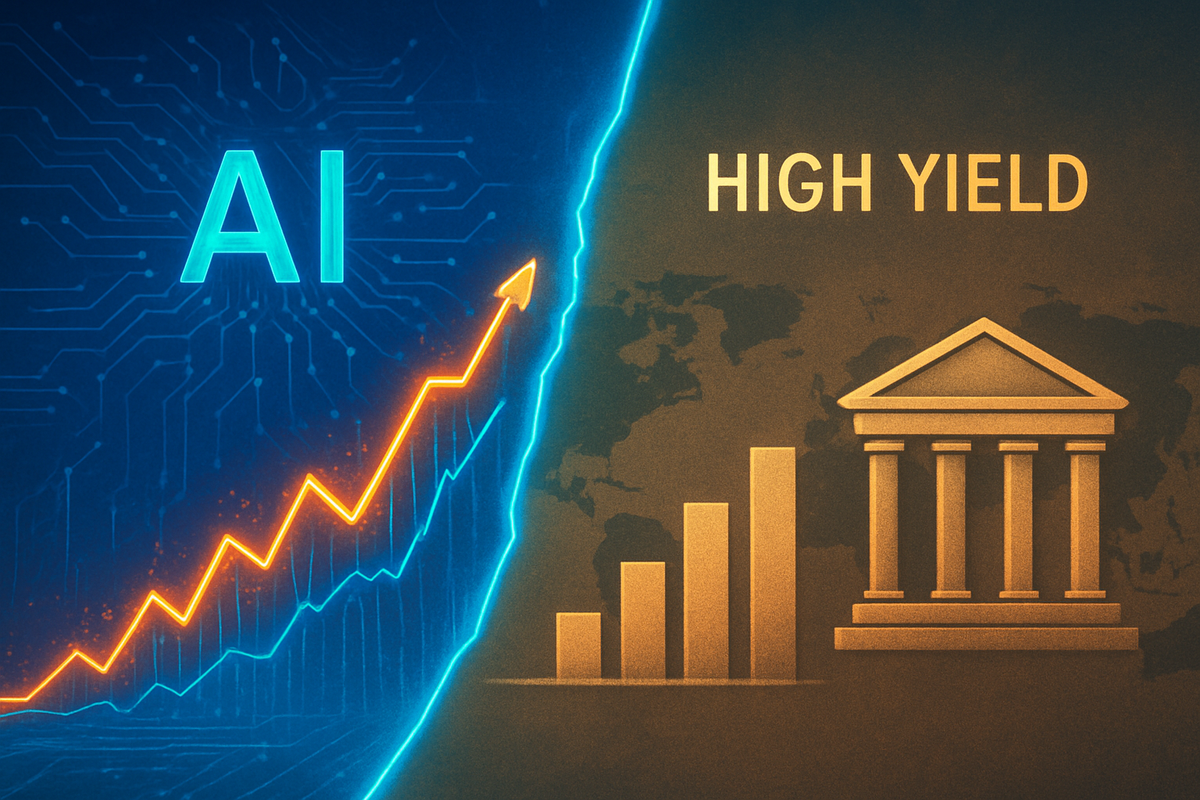
The AI-driven market rally has created a significant divergence in stock performance, heavily favoring growth stocks, particularly those deeply embedded in artificial intelligence innovation. As we approach late 2025, the enthusiasm for generative AI has propelled tech giants and semiconductor firms to unprecedented valuations, while traditional high-yield sectors have largely lagged, prompting investors to re-evaluate their portfolios. This article explores the contrasting fortunes of these two distinct investment categories amidst one of the most transformative technological shifts of our time.
The Genesis of a New Era: AI's Explosive Ascent and Market Reactions
The genesis of the current AI market frenzy can be traced back to early 2023, following the public debut of OpenAI's ChatGPT, which ignited widespread awareness of generative AI's capabilities. This event kicked off a multi-phase rally, initially focused on the "buildout" of AI infrastructure, demanding massive investments in high-performance computing, notably Graphics Processing Units (GPUs). Companies like NVIDIA (NASDAQ: NVDA) became the vanguard of this movement, seeing its stock price skyrocket by over 1,113% from January 2023 to September 2025, even becoming the first company to be valued at $5 trillion in October 2025. This phase has been characterized by hyperscalers pouring billions into data centers, creating a foundational layer for the AI revolution.
As the rally progressed, the focus began to shift towards the "adoption" phase, where AI applications are increasingly integrated across various industries, enhancing products and operational efficiency. Major technology players, including Microsoft (NASDAQ: MSFT) and Alphabet (NASDAQ: GOOGL), have been at the forefront, strategically investing in AI and embedding it across their cloud services and product ecosystems. Microsoft, a key investor in OpenAI, has seen Azure AI services contribute significantly to its revenue, while Google Cloud's AI-driven growth has fueled Alphabet's impressive 50% stock rally in 2025. Other beneficiaries include Amazon (NASDAQ: AMZN) with its AWS AI services, and Meta Platforms (NASDAQ: META), which more doubled its stock price in 2023 due to its AI focus.
In contrast, traditional high-yield stocks, typically found in more mature and stable sectors like utilities, real estate, and consumer staples, have generally underperformed. While these sectors offer stability and regular dividends, the market's intense focus on AI-driven growth has led to a valuation divergence. The equal-weighted S&P 500 has underperformed the market-cap-weighted index, underscoring that gains have been concentrated in a few mega-cap AI stocks. However, some high-yield sectors have found unexpected catalysts. The utilities sector, for instance, rebounded strongly in 2024, driven by the dramatic increase in electricity demand from AI data centers. Companies like Vistra (NYSE: VST) saw their stock prices surge by 261% in 2024, securing strategic agreements with cloud computing giants to supply power at premium prices, showcasing a potential intersection of traditional infrastructure with the demands of the new AI economy.
The Shifting Sands of Corporate Fortunes: Who Benefits and Who Adapts?
The AI-driven market rally has created a stark divergence in corporate fortunes, with a clear hierarchy of winners and a compelling need for adaptation among others. At the apex of this new economic order are the semiconductor and cloud computing giants, whose technologies form the very backbone of the AI revolution. Companies like NVIDIA (NASDAQ: NVDA) continue to dominate, with its GPUs being indispensable for advanced AI, driving its market capitalization past $4 trillion in 2025 and seeing its earnings grow 20-fold over five years. Other semiconductor players such as Broadcom (NASDAQ: AVGO), with AI-related revenues projected to exceed $20 billion in 2025, Advanced Micro Devices (NASDAQ: AMD), and Micron Technology (NASDAQ: MU), a key provider of high-bandwidth memory, are also experiencing unprecedented demand and growth.
The cloud and software titans are equally significant beneficiaries. Microsoft (NASDAQ: MSFT), through its strategic partnership with OpenAI and pervasive AI integration across Azure and its productivity suite, has seen its stock hit all-time highs, with Azure AI services revenue surging by 160% in Q4 2024. Alphabet (NASDAQ: GOOGL) is leveraging its DeepMind and Google Cloud AI initiatives, while Amazon (NASDAQ: AMZN) continues to embed AI into AWS and its vast retail operations. Specialized AI software firms like Palantir Technologies (NYSE: PLTR) have also reported substantial revenue increases, underscoring the broad applicability and demand for AI solutions across commercial and government sectors. The sheer scale of AI infrastructure build-out has also propelled companies like Constellation Energy (NASDAQ: CEG), Vertiv Holdings (NYSE: VRT), and Eaton Corp. (NYSE: ETN), which are critical for powering and cooling the ever-expanding data centers.
Conversely, the AI revolution presents significant challenges and potential "losers" in the traditional sense. Sectors reliant on repetitive human tasks, such as manufacturing, transportation, and customer service, face increasing job displacement as AI and robotics automate processes. Professional services like legal and accounting, traditionally dependent on billable hours for routine work, are seeing revenue streams shrink as AI streamlines document review and tax preparation. While not a sector-wide issue, individual companies struggling with AI integration or facing specific operational challenges, such as C3.ai (NYSE: AI) with its recent stock drop due to missed sales and leadership uncertainty, highlight the risks in this rapidly evolving landscape.
However, many traditional high-yield companies are not merely passive observers but active adaptors. Energy companies like Chevron (NYSE: CVX) are diversifying into providing power solutions for AI data centers, with projects slated for 2027, signaling a strategic pivot to meet new market demands. Utilities such as NextEra Energy (NYSE: NEE) and Vistra (NYSE: VST), along with natural gas midstream leaders like Enbridge (NYSE: ENB) and Kinder Morgan (NYSE: KMI), are poised to benefit from the massive energy requirements of AI infrastructure. The financial services sector is deploying AI to enhance efficiency, fraud detection, and algorithmic trading. Even companies like Qualcomm (NASDAQ: QCOM), known for its mobile chipsets and robust dividends, are integrating AI into its Snapdragon platforms for automotive, IoT, and mobile applications, showcasing how established players can leverage AI to strengthen their core businesses and shareholder returns. The successful integration of AI by these high-yield firms can lead to improved margins, cost reductions, and even new revenue streams, bolstering their business models and dividend sustainability in the long run.
The Broader Canvas: AI's Ripple Effect on Economy, Policy, and History
The AI-driven market rally, as of November 2025, transcends mere stock market performance; it signifies a profound industrial transformation, positioning artificial intelligence as an "undeniable mega-force" reshaping global economies and societies. This era is marked by unprecedented capital investment in physical infrastructure—data centers, AI-specific chips, and enhanced power grids—a phenomenon often likened to a "new coal rush." Indeed, AI infrastructure alone contributed over half of the U.S. GDP growth in the first half of 2025, underscoring its pivotal role in economic expansion and offsetting challenges in other sectors. However, this immense growth is notably concentrated, with a handful of "AI mega-caps" or "Magnificent Seven" tech giants driving the majority of market gains, sparking debates about market sustainability and systemic risks.
This market concentration has exacerbated the performance divergence between growth and high-yield stocks. While the AI mega-caps have seen their collective valuations surge by trillions, traditional value-oriented and high-yield sectors have largely lagged, trading at significant discounts. This "valuation divergence" highlights a market increasingly focused on companies perceived to benefit most directly from AI innovation. Yet, as growth stock valuations become stretched, there are growing signs of capital rotation. Concerns over potential overvaluation, coupled with macroeconomic uncertainties like interest rate decisions, are prompting investors to cautiously shift towards more defensive, value-oriented, and dividend-yielding assets, seeking stability amidst the tech fervor.
The AI revolution is also rapidly accelerating broader industry trends. We are witnessing a swift transition from nascent technology to widespread enterprise adoption, with AI revolutionizing everything from healthcare and finance to retail and manufacturing. The development of "agentic AI"—autonomous AI applications capable of completing tasks end-to-end—promises to redefine work processes and boost productivity significantly, potentially leading to the emergence of "one-person billion-dollar companies." Companies are leveraging AI for enhanced customer experiences, operational efficiency, and advanced analytics, driving a productivity boom expected to contribute substantially to long-term economic growth rates. While 2025 has been characterized by an "AI arms race" focused on infrastructure, the market's attention is anticipated to shift in 2026 towards identifying companies that effectively utilize AI to drive top-line growth and operational margins.
The ripple effects of this transformation are far-reaching. Economically, AI is projected to add trillions to global GDP by 2030, but the immense market concentration in a few AI giants introduces systemic risks; a significant correction in a dominant player could trigger widespread market volatility. Socially, while AI can free employees from tedious tasks, it also raises concerns about job displacement, prompting new regulations like New York's AI Layoff Reporting Requirements. Geopolitically, the AI revolution is intertwined with tensions, leading to new export controls and tariffs, complicating the global competitive landscape. Ethical concerns around privacy, algorithmic bias, and surveillance are also paramount, necessitating careful governance. This has spurred a "regulatory revolution," with over 69 countries drafting more than 1,000 AI-related policies in 2025, focusing on data protection, transparency, ethical AI, and risk-based approaches, exemplified by the European Union's AI Act.
Historically, the current AI market rally often draws comparisons to the dot-com bubble of the late 1990s. Both periods share similarities: rapid valuation growth, significant speculative investment, market concentration in a few dominant players, and growing concerns about "bubble territory." However, many experts argue that the current boom is fundamentally different. Today's leading AI companies often boast stronger fundamentals, with robust profit growth and real demand for their products and services, often "contractually guaranteed" by enterprises. Furthermore, the AI boom is characterized by a massive physical infrastructure expansion, not merely abstract software, implying tangible, energy-intensive demand. While speculative elements may exist, the underlying industrial transformation driven by AI appears to be a robust and enduring force, setting a new precedent for technological impact on global markets.
Navigating the Future: Scenarios and Strategic Imperatives in an AI-Driven World
As we look beyond November 2025, the trajectory of the AI-driven market rally presents a complex interplay of short-term volatility and long-term transformative potential. In the immediate future, AI is poised to remain the primary market driver, with "AI winners"—companies at the forefront of foundational AI technology or successfully integrating AI—expected to continue demonstrating robust earnings growth. Massive capital expenditures in AI infrastructure, driven by hyperscalers like Microsoft (NASDAQ: MSFT), Amazon (NASDAQ: AMZN), Alphabet (NASDAQ: GOOGL), and Meta Platforms (NASDAQ: META), are projected to continue unabated, fueling economic growth. However, this period is also marked by significant volatility, with persistent "AI bubble" concerns leading to recent tech stock declines and a substantial percentage of global fund managers identifying it as the biggest tail risk.
The long-term outlook, conversely, is overwhelmingly positive, painting a picture of a "4th industrial revolution." The global AI market, valued at approximately $391 billion in 2025, is projected to quintuple over the next five years, potentially reaching $1.8 trillion by 2030 and $3.5 trillion by 2033. This growth is expected to supercharge economies through a productivity boom, driven by expanding use cases such as "Agentic AI"—autonomous agents capable of end-to-end task completion—and "Physical AI," the convergence of AI with robotics and smart devices. Unprecedented investments in AI infrastructure, potentially requiring $5.2 trillion to $7.9 trillion in capital expenditures for data center capacity between 2025 and 2030, underscore the foundational shift underway.
In response to this dynamic environment, companies are undertaking significant strategic pivots. Technology giants are increasingly focusing on owning the "picks and shovels" of the AI gold rush, investing heavily in data centers, custom chips, and cloud platforms. Diversification and deep integration of AI capabilities across entire product ecosystems, along with a focus on AI-ready data architecture and talent development, are becoming critical. Aggressive monetization strategies for AI, moving beyond mere infrastructure to premium offerings and industry-specific solutions, will be crucial to justify the colossal investments.
These shifts create a wealth of market opportunities across various segments. Direct investment in AI infrastructure—data centers, specialized chips, power grids, and networking equipment—remains a massive growth area. Opportunities are also broadening into software and service companies that can effectively integrate AI into their offerings. The extensive AI infrastructure build-out also benefits smaller and mid-cap firms in related sectors like electrical equipment manufacturing and heating and cooling. Emerging areas like Agentic AI and Physical AI are expected to create entirely new markets, while the growing complexity of AI systems will fuel demand for advanced cybersecurity solutions.
However, significant challenges loom. "Bubble fears" and concerns about overvaluation, particularly in speculative AI stocks, persist, raising questions about the return on investment for the trillions poured into AI. Infrastructure constraints, notably securing sufficient energy, land, and water for exponentially growing data centers, present a major hurdle. Geopolitical risks, labor market disruption from automation, and complex ethical and governance issues surrounding AI's deployment demand careful navigation. The market's concentration in a few mega-cap AI stocks also poses a challenge to broader market participation and stability.
For investors, several scenarios and outcomes are in play. A continued AI-driven expansion would favor companies with strong fundamentals and clear AI integration strategies. A market correction or "bubble burst" would necessitate caution, with defensive positions and dividend-paying infrastructure stocks offering potential refuges. A bifurcated market with sector rotation could see a few AI winners continue to soar while undervalued sectors, either indirectly benefiting from AI or poised for AI-driven transformation, experience a resurgence. Ultimately, regardless of short-term fluctuations, the long-term structural transformation driven by AI is undeniable. Investors are advised to maintain a long-term perspective, focusing on genuine innovation, ethical AI development, and adaptability, recognizing that continuous research and flexible strategies will be key to navigating this evolving landscape.
The AI Revolution: A Market Transformed and a Future Redefined
As November 2025 draws to a close, the AI-driven market rally stands as a testament to a technological revolution that has fundamentally reshaped financial markets and investor sentiment. The defining characteristic of this era has been an unprecedented surge in capital expenditure, primarily directed towards building out the foundational infrastructure for AI, including vast data centers, specialized chips, and enhanced power grids. This colossal investment, projected to reach US$375 billion in 2025, is considered the largest capital expenditure cycle in decades, dwarfing previous tech booms. At the forefront of this transformation are the "Magnificent Seven" tech giants, with NVIDIA (NASDAQ: NVDA) emerging as the undisputed emblem of the AI era, its market capitalization soaring past $5 trillion in November 2025, driven by a staggering 1190% increase in the past three years.
The rally has been fueled by relentless innovation, particularly in generative AI, which has seen rapid enterprise adoption, rising from 55% in 2023 to 78% in 2024. Consumers, too, have embraced AI tools with unprecedented speed, as exemplified by ChatGPT reaching 800 million weekly active users in less than three years. This widespread integration is translating into significant productivity gains, with projections suggesting AI could lift U.S. productivity by 15% over the next decade. While concerns about an "AI bubble" persist, many analysts argue that the rally is grounded in robust fundamentals and tangible revenue growth, particularly for the leading tech firms, rather than pure speculation.
Moving forward, the market remains largely positive, with AI expected to be the most significant macro factor in 2026, driving continued economic expansion and potentially pushing the S&P 500 to new highs. The focus is shifting from experimental AI models to practical, scalable applications integrated into existing workflows. However, this path is not without its challenges, notably the "New AI Triad" of skilled labor shortages, skyrocketing energy demand for data centers, and the need for vast land for expansion. Scrutiny over valuations and the ultimate return on investment from massive AI outlays will intensify, alongside the growing imperative for clear regulatory frameworks concerning data usage, ethics, and accountability.
The lasting impact of the AI-driven rally is clear: it is a "truly game-changing technology" that will redefine the global economy, boost productivity, and inevitably disrupt labor markets. AI is rapidly becoming the "base behind innovation, productivity, and decision-making" across all industries, promising a foundational shift in how businesses operate and how individuals live.
Crucially, this period has highlighted a stark performance divergence between high-yield and growth stocks. The technology sector and mega-cap AI growth stocks have dramatically outperformed the broader market, with their valuations constituting an increasingly larger percentage of the overall market. These growth-oriented firms, with their direct ties to the AI buildout, are exhibiting exceptional growth rates. In contrast, sectors not directly linked to AI, often associated with high-yield investments such as energy, consumer staples, and real estate, have largely stagnated or seen comparatively modest gains. While high-yield stocks offer stability, their performance has considerably lagged the explosive growth seen in AI-driven technology.
For investors navigating this transformed market in the coming months, diversification remains paramount to balance exposure to high-growth, high-valuation assets with more defensive positions. It is essential to focus on the entire AI value chain, looking beyond just the leading chipmakers to include companies enabling technologies, intelligence layers, and application layers, as well as those effectively applying AI to boost their own productivity. Investors must monitor monetization and return on invested capital (ROIC), scrutinizing whether massive AI investments are translating into concrete revenues and strong profitability. Paying close attention to how companies address the "New AI Triad" challenges—labor, energy, and land—will be critical. Furthermore, staying abreast of the evolving regulatory landscape and assessing fundamentals beyond the hype will be crucial to identifying true winners and avoiding speculative pitfalls. Finally, do not overlook the "Old Economy" spillover, as sectors indirectly benefiting from AI infrastructure buildout, such as construction for data centers or telecommunications installing networking equipment, may offer more stable, albeit less explosive, returns. The AI revolution is here to stay, but discerning sustainable growth from speculative fervor will be the hallmark of successful investing.
This content is intended for informational purposes only and is not financial advice








